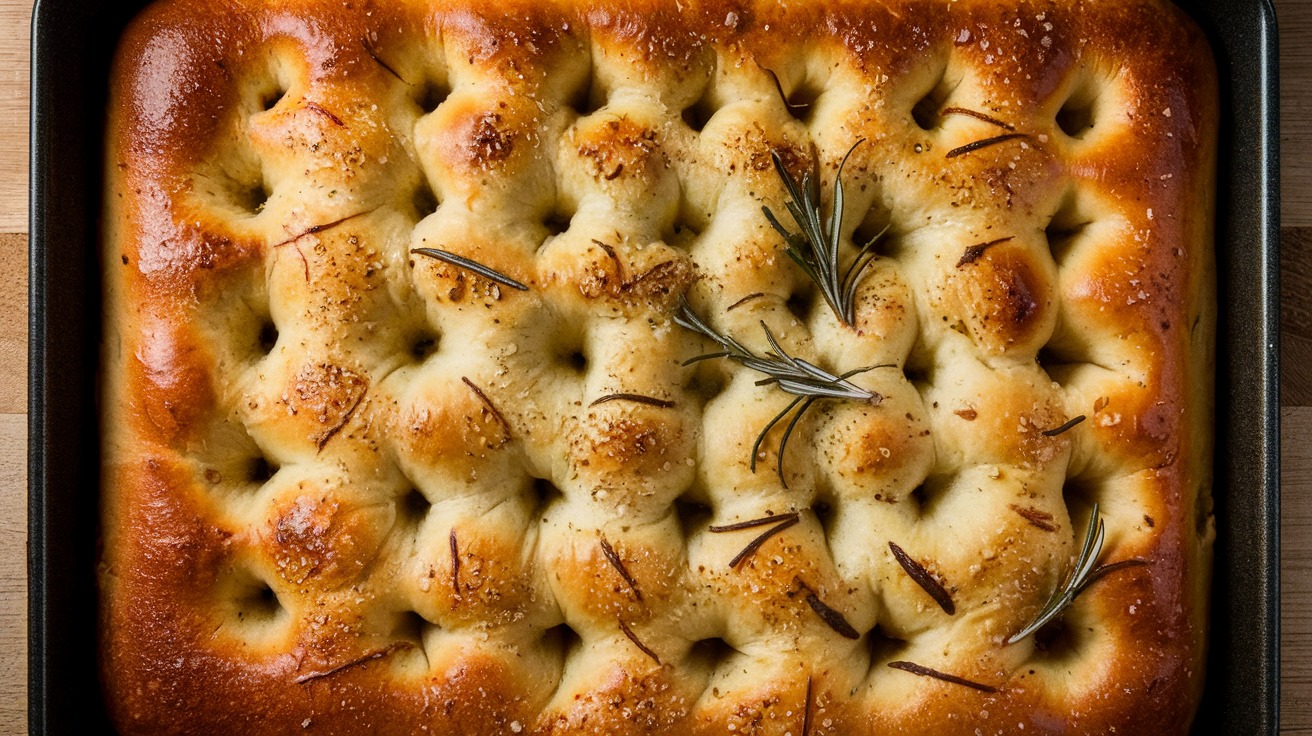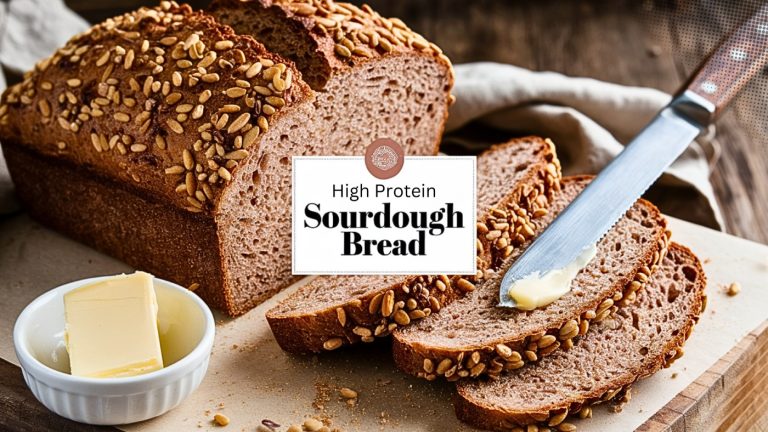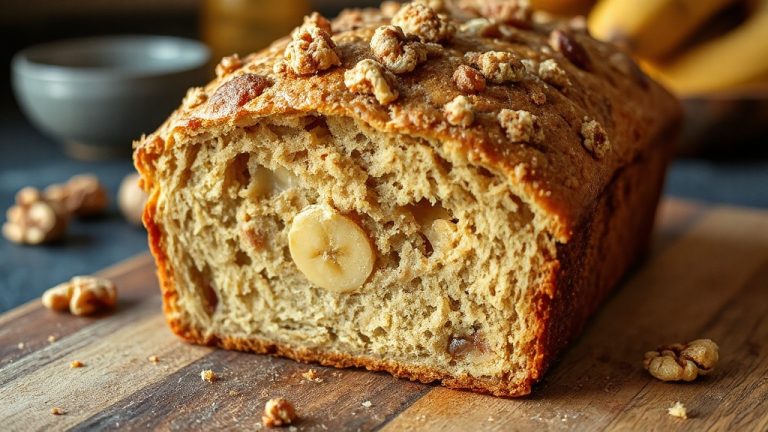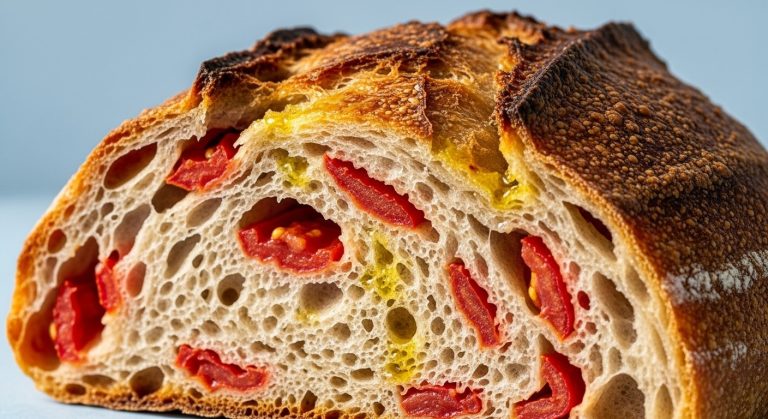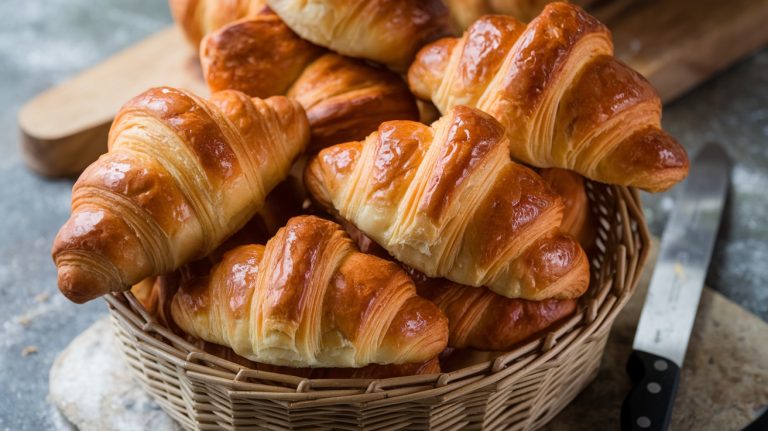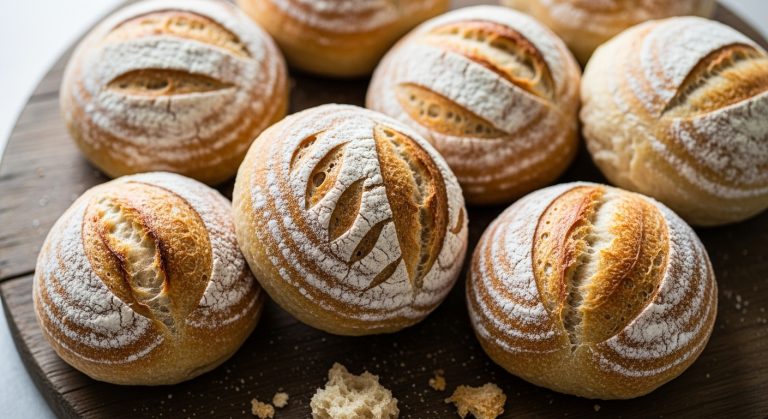Samin Nosrat Focaccia Recipe: Simple but Flavourful
Samin Nosrat’s focaccia recipe invites you to create a soft, airy bread that’s a delight at any meal. You’ll need simple yet quality ingredients like lukewarm water, active dry yeast, all-purpose flour, and extra-virgin olive oil.
Start by mixing the water, yeast, and honey, then combine it with flour and salt. Let the dough ferment overnight to develop flavor.
Dimpling the dough creates delicious pockets for brine, enhancing taste. Once baked to a golden brown, enjoy your focaccia warm or as a sandwich base. You might discover other tips and techniques to elevate your bread game.
Key Takeaways
- Focaccia is a traditional Italian bread with a golden crust and airy interior, ideal for various meals and snacks.
- The recipe requires key ingredients: lukewarm water, active dry yeast, all-purpose flour, kosher salt, and high-quality extra-virgin olive oil.
- Follow steps for dough preparation, including mixing, fermenting overnight, and gentle folding to maintain texture.
- Dimpling the dough before baking enhances flavor by allowing brine to infuse and retain moisture during cooking.
- Bake at 450°F for 25-30 minutes, adding flaky salt for extra flavor, and enjoy fresh for the best texture.
Key Ingredients
When crafting Samin Nosrat’s focaccia, you’ll want to gather a few key ingredients that make all the difference in flavor and texture. Each component plays a crucial role in creating that perfect, airy bread, much like the essential ingredients needed for a successful sourdough loaf, such as sourdough starter readiness.
- 2.5 cups of lukewarm water: This hydrates the flour while activating the yeast.
- 1/2 teaspoon of active dry yeast: Necessary for leavening, it helps the focaccia rise beautifully.
- 5 1/3 cups of all-purpose flour: The backbone of your dough, it provides structure.
You’ll also need kosher salt, specifically Diamond Crystal, as its unique texture guarantees the right level of seasoning without overpowering the dish. Use 2 teaspoons for the dough and mix 1.5 teaspoons with 1/3 cup of lukewarm water to create a brine that enhances moisture and flavor.
Don’t forget the high-quality extra-virgin olive oil; it adds richness and depth. Finally, consider adding fresh herbs like rosemary for an aromatic touch that elevates your focaccia experience.
Dough Preparation Steps
To kick off your focaccia journey, you’ll start by mixing lukewarm water, yeast, and honey until dissolved, creating a lively base for your dough. Next, combine flour and salt before introducing the yeast mixture and olive oil, stirring until everything comes together. After that, let the dough ferment overnight, allowing it to rise and develop those delicious flavors you’ll love.
Ingredient Mixing Techniques
In the art of making focaccia, the initial mixing of ingredients sets the foundation for a delicious, airy bread. Start by combining 2.5 cups of lukewarm water, ½ teaspoon of active dry yeast, and 1 tablespoon of honey in a medium bowl. This yeast mixture needs to become foamy, ensuring proper activation.
Meanwhile, in a large bowl, whisk together 5⅓ cups of all-purpose flour and 2 tablespoons of Diamond Crystal kosher salt, guaranteeing the salt is evenly distributed for ideal flavor. This step is essential as even salt distribution can enhance the overall taste of the bread, similar to how sourdough bread preparation emphasizes ingredient layering for success.
Once your yeast mixture is ready, it’s time to combine everything. Add the yeast mixture and ¼ cup of extra-virgin olive oil to the flour mixture. Use a rubber spatula to incorporate the ingredients until no dry flour remains. This process is vital as it helps form a cohesive dough.
Remember these key techniques:
- Ensure even salt distribution.
- Activate your yeast properly.
- Mix thoroughly until no dry flour is visible.
After mixing, cover the bowl tightly and let the dough ferment at room temperature. Soon, you’ll witness it double in volume, ready for the next steps!
Dough Fermentation Process
After mixing the ingredients, the dough fermentation process begins, where the magic truly happens. You’ll start by combining 2.5 cups of lukewarm water, ½ teaspoon of active dry yeast, and 1 tablespoon of honey in a medium bowl.
This activates the yeast, allowing it to dissolve and work its wonders while creating a favorable environment for yeast and bacteria activity, as highlighted in bulk fermentation tips. In a large bowl, whisk together 5⅓ cups of all-purpose flour and 2 tablespoons of Diamond Crystal kosher salt, then add your yeast mixture along with ¼ cup of extra-virgin olive oil.
Stir these combined ingredients with a rubber spatula until everything is fully incorporated, scraping the sides of the bowl to eliminate any dry flour. Now, cover the bowl tightly with plastic wrap and let the dough ferment at room temperature for 12 to 14 hours. During this time, it’ll double in volume and become bubbly, signaling that the fermentation is successful.
Once fermentation is complete, gently release the dough from the bowl and fold it onto itself. This step helps develop the structure before you transfer it to an oiled baking sheet for further shaping and dimpling.
Dough Handling
Once your dough has fermented, you’ll want to handle it with care to keep that airy texture intact. It’s essential to use a quality proofing basket, such as those made from natural rattan, to support the dough’s structure during fermentation.
Gently fold it onto itself and then dimple the surface with your fingers, creating little pockets that will hold all that delicious brine. This technique enhances flavor absorption and guarantees a beautifully textured focaccia, making it a perfect candidate for your best sourdough proofing baskets.
Gentle Dough Folding
As you prepare to shape your focaccia, gentle dough folding is vital for achieving that light, airy texture. Start by gently releasing the dough from the bowl with a rubber spatula, being careful not to deflate it too much. This step helps maintain the airy structure important for focaccia.
Next, fold the dough onto itself in a series of gentle motions. Remember, your goal is to preserve the gas bubbles created during fermentation. After folding, drizzle a light amount of olive oil over the dough; this not only prevents sticking but also enhances the flavor and texture.
When it’s time to stretch the dough, use your fingertips to push it to the edges of the baking sheet gradually. This technique guarantees that the dough will remain intact without tearing.
Keep these tips in mind:
- Gently fold the dough to preserve air bubbles.
- Lightly oil to enhance flavor and prevent sticking.
- Stretch with care to maintain the dough’s structure.
Dimpling for Flavor
With your dough gently folded and ready, it’s time to focus on the art of dimpling. This technique not only enhances the flavor but also transforms your focaccia into a delightful masterpiece. By dimpling the dough with your fingers at an angle, you create small pockets that hold the brine, adding moisture and a distinct saltiness during baking.
As the olive oil pools in these dimples, it contributes to the rich, savory taste characteristic of Ligurian focaccia. Dimpling also helps prevent the dough from puffing up too much in the oven, ensuring a more even texture throughout. Just remember to be gentle while dimpling; you want to maintain the airy quality achieved from the fermentation process.
Baking Process
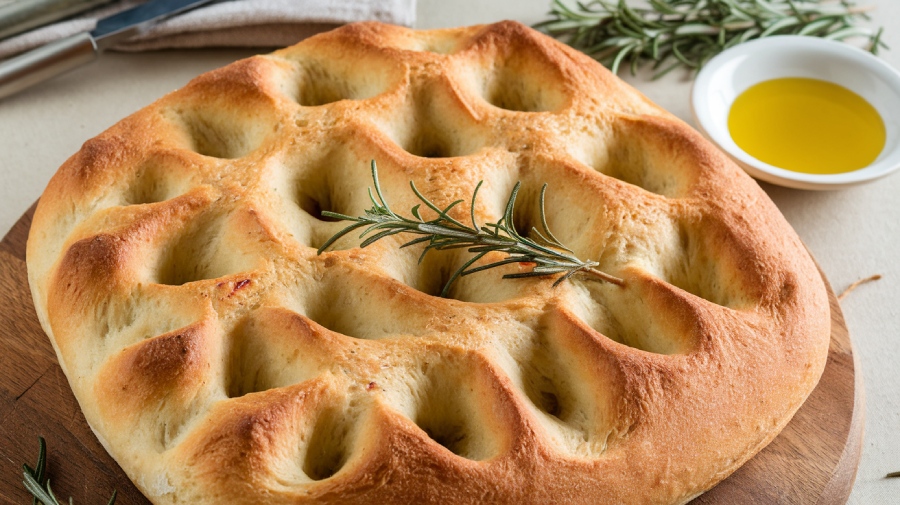
The baking process for Samin Nosrat’s focaccia is where the magic truly happens. Begin by preheating your oven to 450°F (235°C). While it’s heating, place a baking stone or an inverted sturdy baking sheet inside to guarantee even heat distribution. This step is essential for achieving that perfect bottom crust.
Once your oven is ready, it’s time to sprinkle flaky salt over the focaccia. This not only enhances flavor but also contributes to a delightful, crispy crust. Now, slide your focaccia into the oven and bake for 25 to 30 minutes. You’ll want to keep an eye on it until the bottom crust turns a beautiful golden brown and the top crust crisps up.
For an extra touch of browning, you can move the focaccia to the upper rack of the oven for an additional 5 to 7 minutes.
Don’t forget to brush the freshly baked focaccia with olive oil. This adds richness and allows it to absorb the flavor as it cools. Follow these steps for a perfectly baked focaccia that’ll impress everyone!
- Preheat your oven.
- Use a baking stone or sheet.
- Brush with olive oil after baking.
Proofing and Final Touches
Proofing your dough is an essential step in creating that airy, delightful texture in Samin Nosrat’s focaccia. After you’ve dimpled the dough, let it rise for about 45 minutes. You’ll know it’s ready when it appears light and bubbly, signaling proper fermentation.
Meanwhile, preheat your oven to 450°F (235°C). This high temperature is key, so consider using a baking stone or an inverted baking sheet to guarantee even heat distribution. Just before you place the focaccia in the oven, sprinkle a generous amount of flaky salt over the surface. This not only enhances the flavor but also contributes to that irresistible texture.
Once your focaccia’s been baking for 25-30 minutes, move it to the upper rack for an additional 5-7 minutes. This helps achieve a beautifully crisp crust. When it’s golden and fragrant, take it out and brush it with olive oil for a rich finish. Allow it to cool for about 5 minutes on a cooling rack so it can absorb the oil, enhancing its flavor and texture even further.
Serving Suggestions
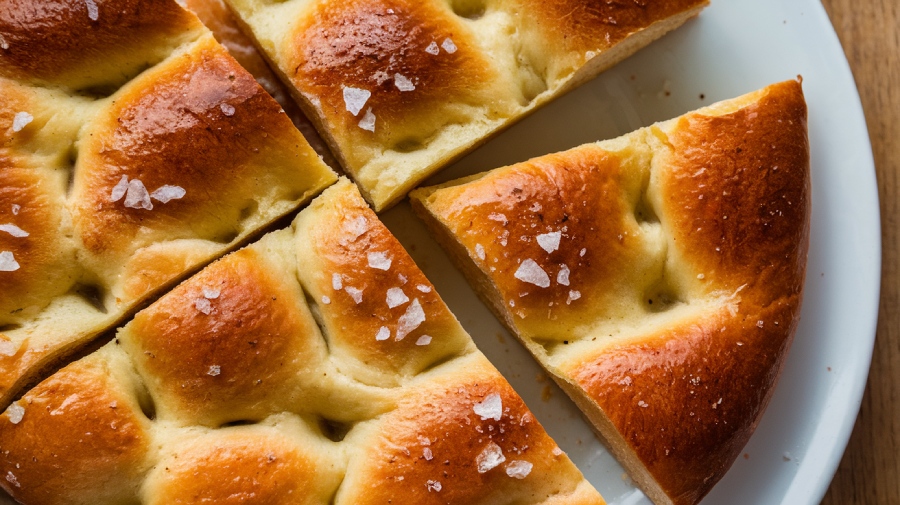
Elevating your dining experience, focaccia shines in various serving scenarios. Whether you’re enjoying a cozy meal or hosting friends, this versatile bread can enhance your table effortlessly. Serve it warm, and watch as it becomes a delectable snack, perfect for dipping in olive oil or balsamic vinegar.
Here are a few mouthwatering serving suggestions for your focaccia:
- Sandwich Base: Its thick and airy texture makes focaccia an excellent sandwich base, holding various fillings without crumbling.
- Accompaniment: Pair it with soups and salads, adding a hearty element that balances lighter dishes.
- Antipasto Platters: Focaccia complements cured meats, cheeses, and marinated vegetables beautifully, making it a star on any antipasto platter.
Don’t forget about leftover focaccia! You can transform it into croutons for salads or even blend it into a delicious bread pudding, maximizing its use while minimizing waste.
Storage Tips
Storing leftover focaccia properly can make all the difference in maintaining its delightful texture and flavor. To keep your focaccia fresh, wrap it in parchment paper and store it in an airtight bag or container at room temperature. This method helps retain moisture while preventing it from becoming too soggy.
If you want to enjoy that crispy bite again, reheating or toasting the focaccia before serving is highly recommended. Just pop it in the oven or on a skillet for a few minutes, and you’ll have a delightful treat that feels freshly baked.
If you anticipate not finishing your focaccia within a couple of days, consider freezing it. Just make certain to tightly wrap it in a sealed bag to prevent freezer burn. Focaccia can be frozen for up to three months, making it a great option for meal prep or unexpected guests.
When you’re ready to enjoy your frozen focaccia, allow it to defrost at room temperature before reheating.
Frequently Asked Questions
Can I Use Whole Wheat Flour Instead of All-Purpose Flour?
You can definitely use whole wheat flour instead of all-purpose flour! Just remember, it’ll make your focaccia denser and affect the texture. Adjust hydration and kneading time to achieve the best results. Happy baking!
How Long Can I Refrigerate the Dough Before Baking?
You can refrigerate your dough for up to 72 hours. Notably, cold fermentation improves flavor, enhancing the final product. Just remember to let it rest at room temperature for about 30 minutes before baking!
What Should I Do if My Dough Doesn’t Rise?
If your dough doesn’t rise, check the yeast’s freshness, guarantee the environment’s warm enough, and give it time. Knead it gently, then try again. Sometimes, a little patience yields the best results for your bread.
Can I Add Cheese or Other Toppings to the Focaccia?
Absolutely, you can add cheese or toppings to your focaccia! Just sprinkle them on before baking, pressing them gently into the dough. Experiment with different flavors; it’ll enhance the texture and taste beautifully. Enjoy your creation!
Is It Necessary to Use Fresh Herbs?
Using fresh herbs isn’t strictly necessary, but they elevate your focaccia’s flavor beautifully. Fresh rosemary, thyme, or basil adds aromatic depth, making each bite more delightful and inviting.
More Than Bread: Crafting a Masterpiece with Every Slice
Ultimately, you’ve not just baked focaccia; you’ve created a masterpiece. You’ve embraced the art of dough, savored the aroma of fresh herbs, and celebrated the joy of sharing.
With each golden slice, you’ve indulged in a symphony of flavors that dance on your palate. So, gather your loved ones, relish the warmth of your kitchen, and enjoy the delicious rewards of your efforts. Remember, every bite tells a story, and you’re the author of this delightful experience.

